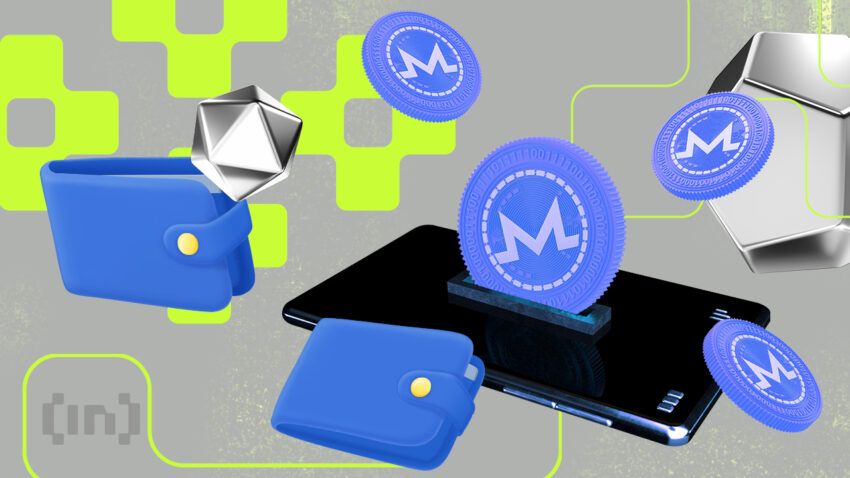Mining Monero provides an accessible path to acquiring cryptocurrency by utilizing your current device. However, it’s crucial to consider various facets of the mining process. To assist you, we’ve conducted thorough research and compiled an in-depth, step-by-step guide that covers all the essentials you need to know for effective monero mining.
Want to get reviews on the best crypto projects for mining? Join BeInCrypto Trading Community on Telegram: read reviews, discuss crypto projects, ask for technical analysis on coins and get answers to all your questions from PRO traders & experts! Join now
Interested in cloud mining on 🔥ECOS? Don’t Wait. Sign Up Today!
What is Monero?
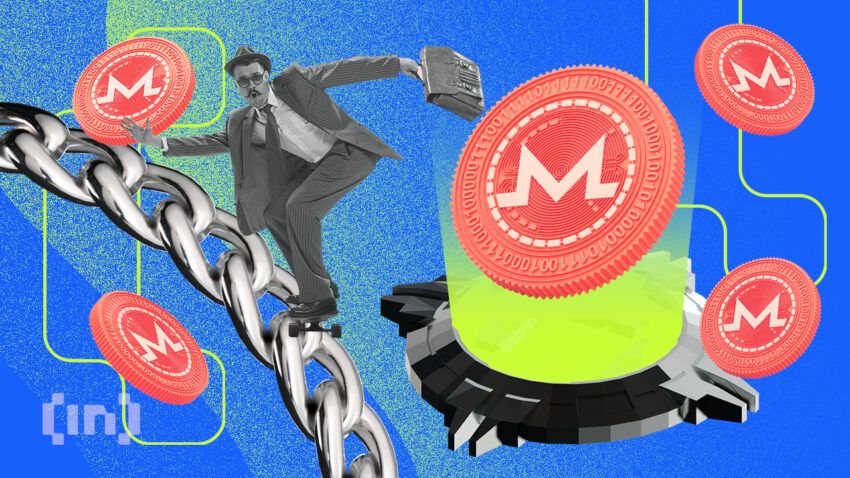
Launched in 2014, monero (XMR) is an open-source cryptocurrency that received recognition for its high anonymity. Monero is similar to bitcoin, but its distinguishing feature is its privacy features.
Monero differentiates itself by making its transactions private and untraceable. Its blockchain obfuscates transaction details, including the trader’s identity and the transaction amount. This makes it a truly anonymous cryptocurrency.
Although some have contested the privacy feature of XMR, it still stands as a top cryptocurrency considering its market capitalization, standing at about $2.8 billion. Monero has a total supply of about 18 million XMR, hard-built into the source code.
How does Monero work?
Monero uses a proof-of-work (PoW) consensus mechanism, which requires computational power to generate blocks on the Monero network, just like bitcoin. However, XMR can be mined by any miner using their device’s CPU or GPU.
The Monero community stands for an egalitarian concept and believes that all people deserve equal opportunities. They also chose this model to improve Monero’s decentralization, and that’s why XMR mining doesn’t support application-specific integrated circuits (ASICs).
In November 2019, RandomX hashing algorithm replaced CryptNight, which discourages the use of ASICs. The same proof-of-work algorithm, PoW RandomX, is also penalizing miners using GPU for monero mining.
The Monero community wants to keep specialized hardware equipment not suitable for XMR mining. ASICs, for instance, are used for mining bitcoin. Due to their high price, only some miners can afford to buy the equipment, thus making the miners and the network more centralized. And that’s exactly what monero tries to avoid.
Monero (XMR) is a fungible digital currency, which means that if you exchange one XMR for another, you receive the exact value, and there is no difference between the two.
Although, in essence, bitcoin is also fungible, it allows anyone to trace back any coins that may have been involved in gambling, theft, or fraud, and some services do not accept these funds.
Monero, in contrast, doesn’t allow anyone to trace the transaction history of the coin. Users are not in any danger of bans from services for holding blacklisted funds. If you are interested in buying Monero, you can purchase it on platforms like OKX.
What is Monero used for?
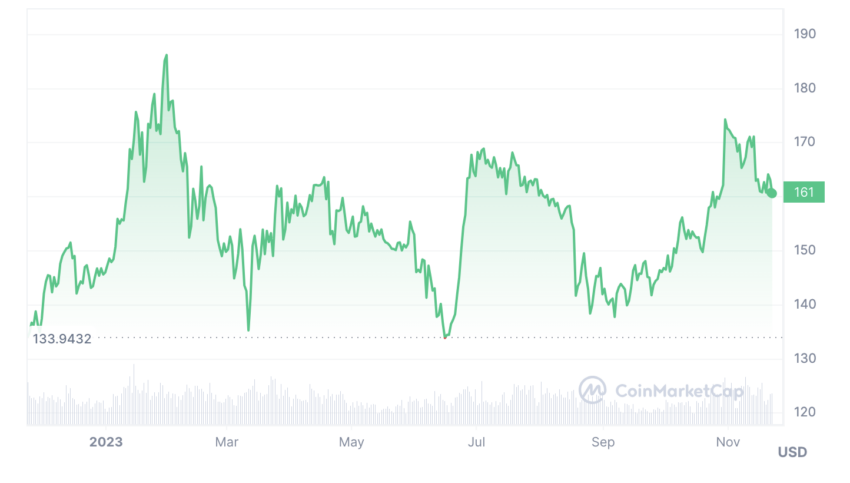
Monero (XRM) is perfect for anonymous and fast transactions. Although many have argued that its privacy features enable transactions on the dark web, there are legitimate use cases for Monero.
Monero enables businesses to keep their account information private. Given the number of financial crimes happening every day, malicious individuals can use the information revealed by simple financial transactions for their benefit. This is a valid use case for any business, as it helps them keep their data private.
But privacy is much needed by individuals as well, not just businesses. By openly disclosing your spending and financial data, big companies such as Facebook and other data mining companies can sell it to the highest bidder.
In general, people and companies do not advertise their revenues and salaries for the exact purpose of avoiding intentional crime. Having a public and transparent ledger is great for a world without financial crime, but that’s not the world we live in.
Monero wallets
A monero wallet is a software or a service that holds your public and private keys and corresponds with the Monero blockchain.
Monero users can choose between a variety of monero wallets:
- Software wallet (MyMonero)
- Mobile wallet (Cake wallet, Monerujo, MyMonero, Edge)
- Full node wallet (Monero GUI)
- Hardware wallet — also called cold wallets (Ledger, Trezor)
While the hot wallet, or the software wallets, are free to use and provide quick access to your funds, it’s better to use those just for funds you frequently trade. Hot wallets are always connected to the Internet, and this might give hackers easy access to your crypto.
Cold wallets, such as hardware wallets, are the safest wallet for crypto, meant for investors who are looking for long-term storage options.
Exchange wallets can also be used to buy and hold monero. The most used centralized exchanges for buying crypto are Gate.io, CoinEX, Poloniex, Bittrex, Bitfinex, and Kraken.
Miners need a wallet address to send their mining rewards.
How XMR mining works
Monero mining works on any operating system, such as Windows, macOS, Linux, or Android.
Two choices exist:
- Join mining pools
- Mine individually
The good news about mining XMR is that any standard computer can become a miner. Miners do not require ASICs to mine monero. To become a miner, you will need to use special software for mining monero.
Miners verify transactions on the Monero blockchain, helping generate the next block on the network. They are rewarded with XMR. It’s important to note that monero doesn’t have a hard cap, like bitcoin, which has a fixed supply of 21 million. Mining helps to secure the Monero network. This is why there is technically no fixed supply for XMR. Verifying transactions allows miners to receive rewards, even after te max supply has been reached.
Since all monero coins have been discovered (~18.132 million XMR), the monero mining rewards have a fixed value. Since May 2022, A “tail emission” generates 0.6 XMR rewards per block infinitely to keep miners motivated. This translates to <1% inflation decreasing over time.
A new block is mined every two minutes, and the reward is 0.60484 XMR, indefinitely. Since all the Monero supply is already in circulation, the block rewards will not change anymore. This feature is hard-coded into the source code. Please check the more details about rewards for mining monero here.
What to consider before mining monero
Crypto enthusiasts become monero miners to support the blockchain and earn an income. Here’s what you should be considering before mining monero.
Profitability
Before you start learning how to mine monero using your CPU or buy other equipment, it’s important to consider the profitability of mining monero.
The key factors to take into consideration before determining if mining monero is profitable are:
- The mining hardware hash rate
- Electricity costs
- Mining pool fees
Monero mining calculator
To further determine if mining monero is a profitable business for you, you can use the monero mining calculator. Use this tool to introduce your computer’s hash rate, power consumption, and energy costs to see what the profit would be if you want to start mining monero.
The calculator is regularly updated with the latest block mining data.
Hash rate
An important fact to know is that mining cryptocurrency is a matter of time, and the miner who solves the computational puzzle first gets the reward. Therefore, you will be more profitable if you have a device with a high processing speed. That’s why most individuals who are mining crypto invest in specific mining devices.
The hash rate is used to measure the speed of your device to mine crypto. The hash rate is the number of calculations a device can process per second.
Here are three popular CPUs for mining monero:
- AMD Threadripper 3990X
- AMD Ryzen 9 3900X
- Intel Core i9-10900K
Different ways to mine monero
There are a few options when it comes to monero mining. You can be a solo XRM miner, join a monero mining pool, or use cloud mining services.
As a solo miner, the main advantage is that you get the entire reward for mining a monero block. However, solo miners might win rewards less frequently than mining pools.
One of the easier ways to start mining — mining pools — do, however, charge a service fee (0–2%), with rewards divided between all the miners of the pool. Some of the most popular monero mining pools are MoneroOcean, XMRPool, and 2miners. You can check mining pools in real-time on miningpoolstats.stream.
MoneroOcean is a mining pool that has the multi-coin profit switch feature. This means that the pool calculates what is the most profitable coin to mine at the moment and switches to that.
The biggest benefit of mining pools is that you receive rewards more often. It’s worth noting that the software used for mining might ask for a small fee from your earnings.
For individuals who do not want to be part of a mining pool, it is worth checking out monero cloud mining, such as Minergate and CCGMining. These service providers offer the processing power for a fee.
How to mine monero
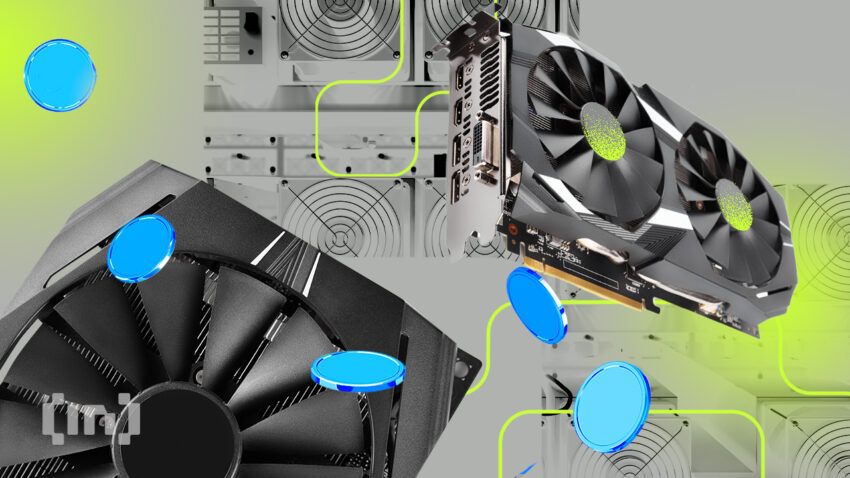
How to mine XMR and make a profit?
Start mining right away using the CPU or GPU of your device. To achieve profitability, you should equip yourself with hardware capable of delivering a high hash rate. When it comes to CPU mining, the most straightforward approach is to utilize the CPU of your existing device. You have the option to buy a specialized CPU dedicated to mining. Additionally, you can decide to mine on your own or join a mining pool to collaborate with others.
Step 1: Get a monero wallet
You need to download, install, and set up a crypto wallet, using one of the supported monero wallets. You can use any of the wallets that are supporting monero for this part.
If you want to stake your XMR further, you can use a wallet on a crypto exchange that supports monero, such as Hotbit and others. Setting up a wallet on a crypto exchange is fairly easy, but be aware that most exchanges require you to complete KYC as part of the signing up.
We will use MyMonero wallet.
Install the application on your desktop. Create a wallet. Make sure to write down your mnemonic phrase to be able to recover your wallet in case something happens to your device.
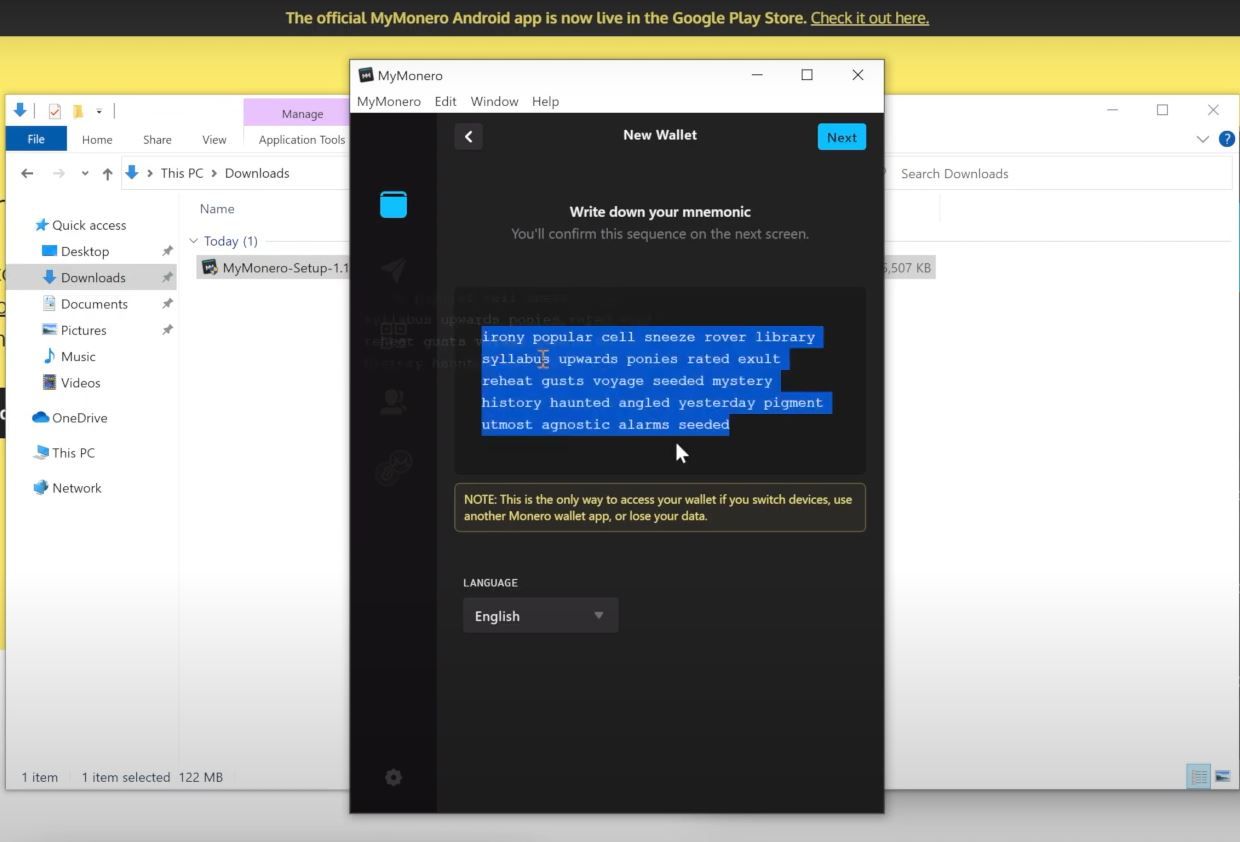
The next step is to write your mnemonic phrase.
You will also be asked to create a PIN or a password to access the wallet on the device.
And that’s it. You have created your wallet, and you have the wallet’s address.
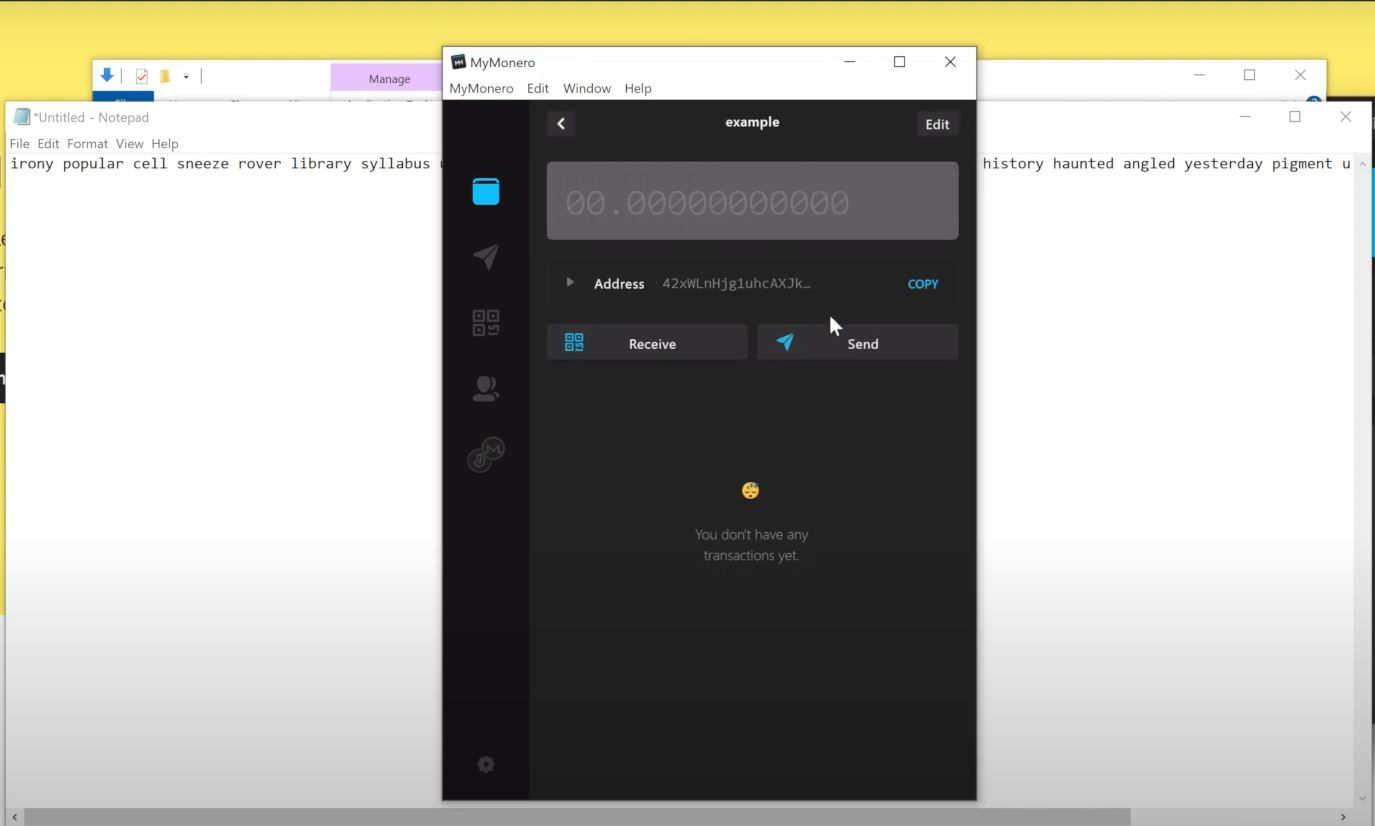
This is where the monero mining rewards will be stored.
Step 2: Mining software
One of the most popular monero mining software is XMRig. Download the software from its website. Extract the zip files.
On Windows, you will receive a warning saying that the mining software might trigger the antivirus software. You will need to add an exception for the software to prevent the system from removing the file.
Step 3: Window Security exclusion
To add an exception, on Windows — for the monero mining software — go to Windows Security > Virus & Threat Protection > Virus & Threat Protection Settings > Manage Setting > Exclusions.
Click on “Add or Remove exclusions.” And then “Add an exclusion.” Add the exclusion for the entire folder. Select “Folder” and search for the location where you unzipped the monero mining software. You will be prompted to accept the security warning from Windows.
Now, you can see the added exclusion for Windows Security.
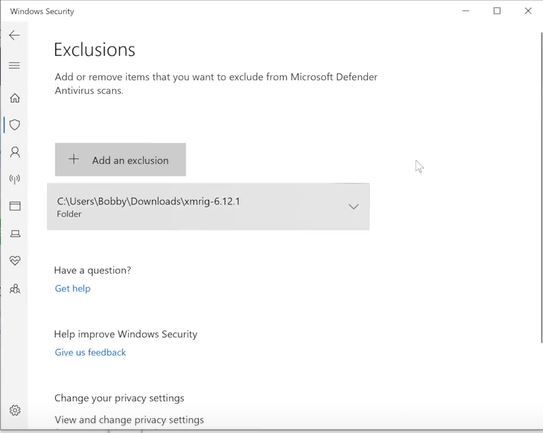
You will also need to unblock the mining software to be able to later run it. To do that, right-click on the mining software.
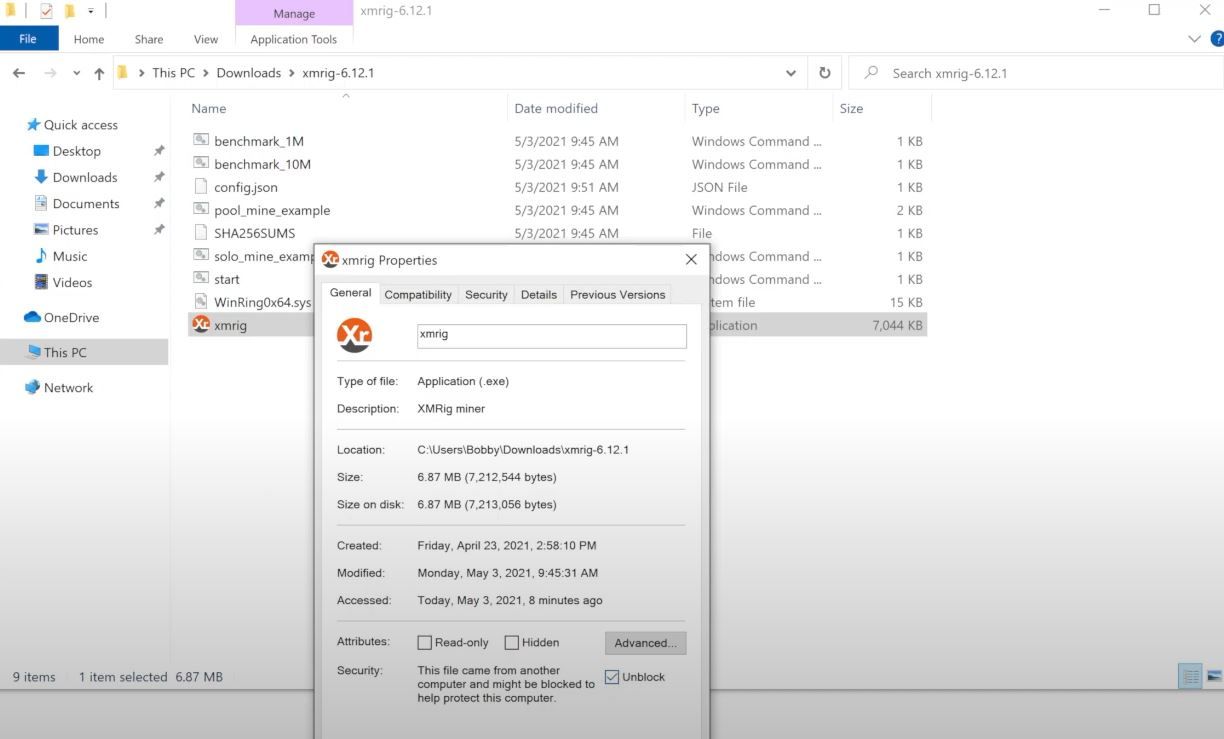
Under Security, check the “Unblock” box and click “Apply”.
Next, you will need to configure the software to be tied to your wallet and mining pool. This can be done by customizing the file “config.json.”
Step 4: Choosing a monero mining pool
Before generating the configuration file, you need to pick a mining pool or mine by yourself. It is unlikely that, as a solo miner, you will have enough CPU to gain profitable rewards, and that’s why most miners choose to be part of a mining pool.
You can find all the monero mining pools on miningpoolstats.stream/monero. You will see the top mining pools that are supporting Monero. Because the community aims to keep miners decentralized, it’s best to keep away from those top ones.
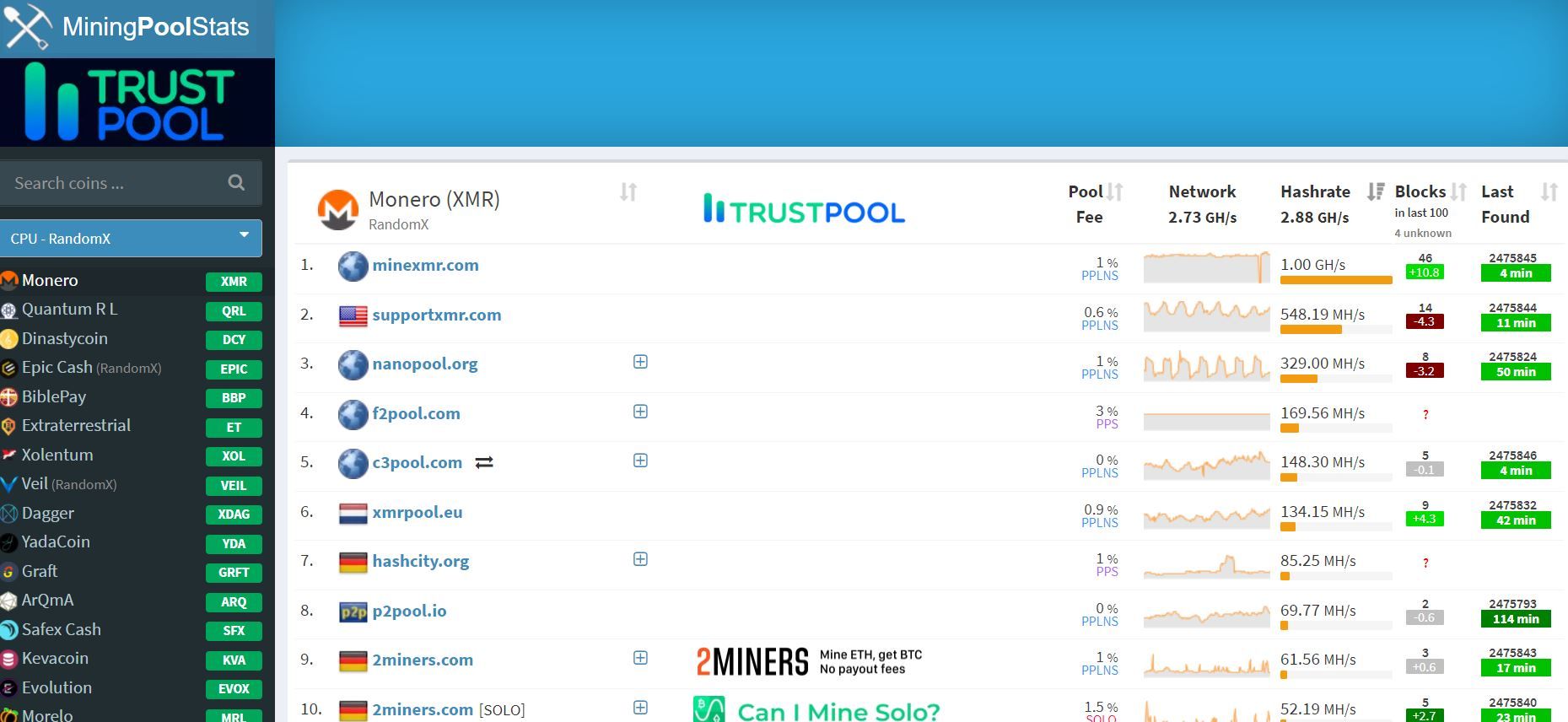
You can click on each pool to get to its website. That’s where you’ll see that your machine is mining and successfully communicating with the pool.
Step 5: Generate the config.json file
You can generate the file needed for the monero mining software on XMRig.
Go to “Wizard” > “+New Configuration” > “+Add Pool” (add the chosen mining pool) > “Add a Monero wallet address”.
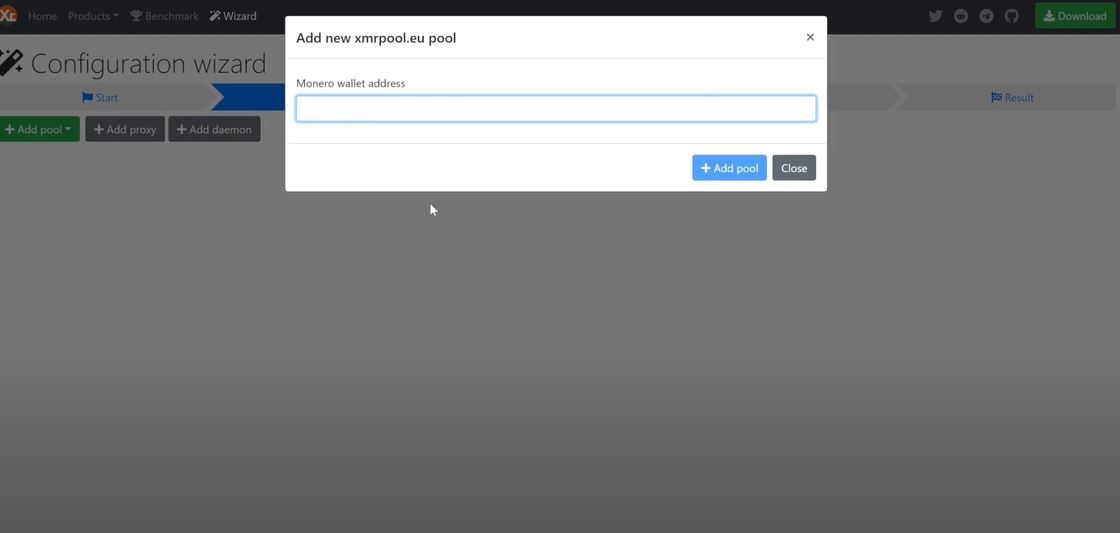
Enter the wallet address you created in Step 1. Go to MyMonero wallet, copy the public address, and paste it here. Click “+Add pool.” You will see your pool added.
Go to the next step of the wizard, which is “Backends.” Select the CPU option.
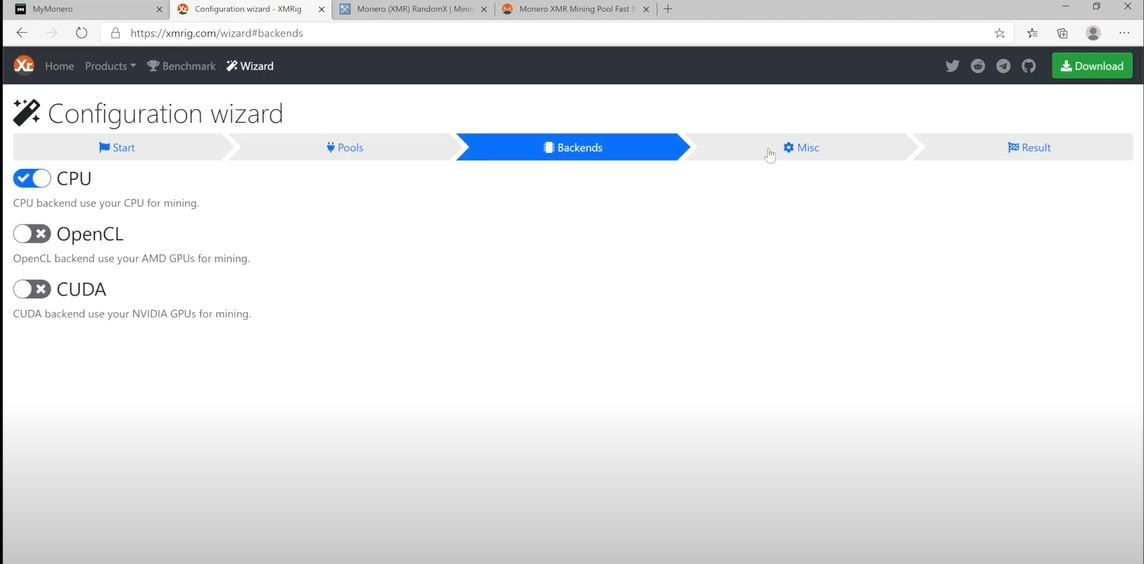
The next step is “Misc,” where you choose the percentage you want to donate to XMRig for writing the software.
Next, click on the “Result” tab to see and download the config file.
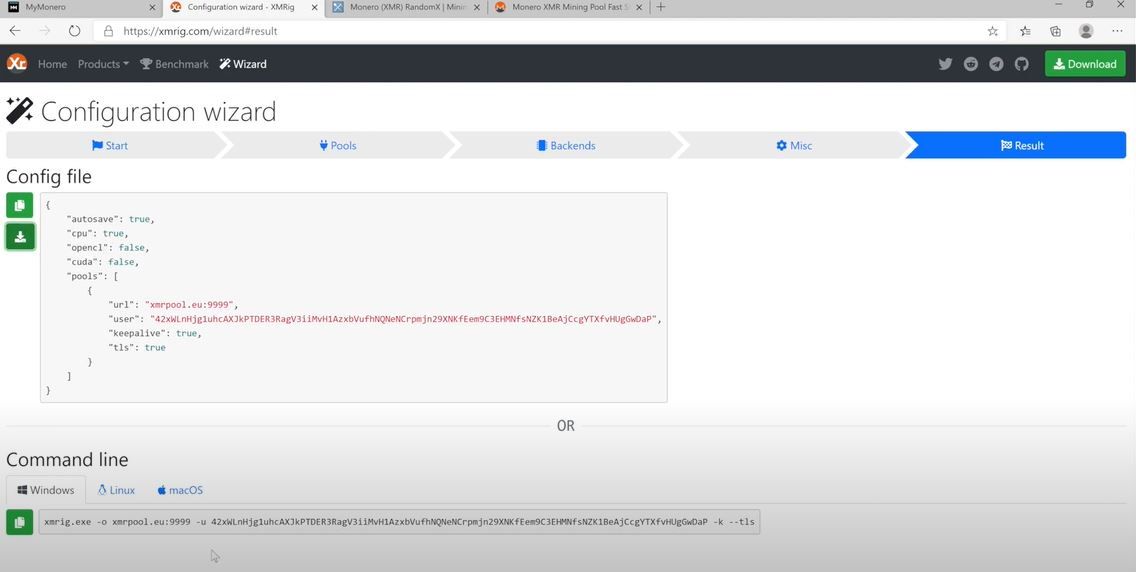
Download this config file and use it to replace the default file that came with the software, in the folder you unzipped earlier.
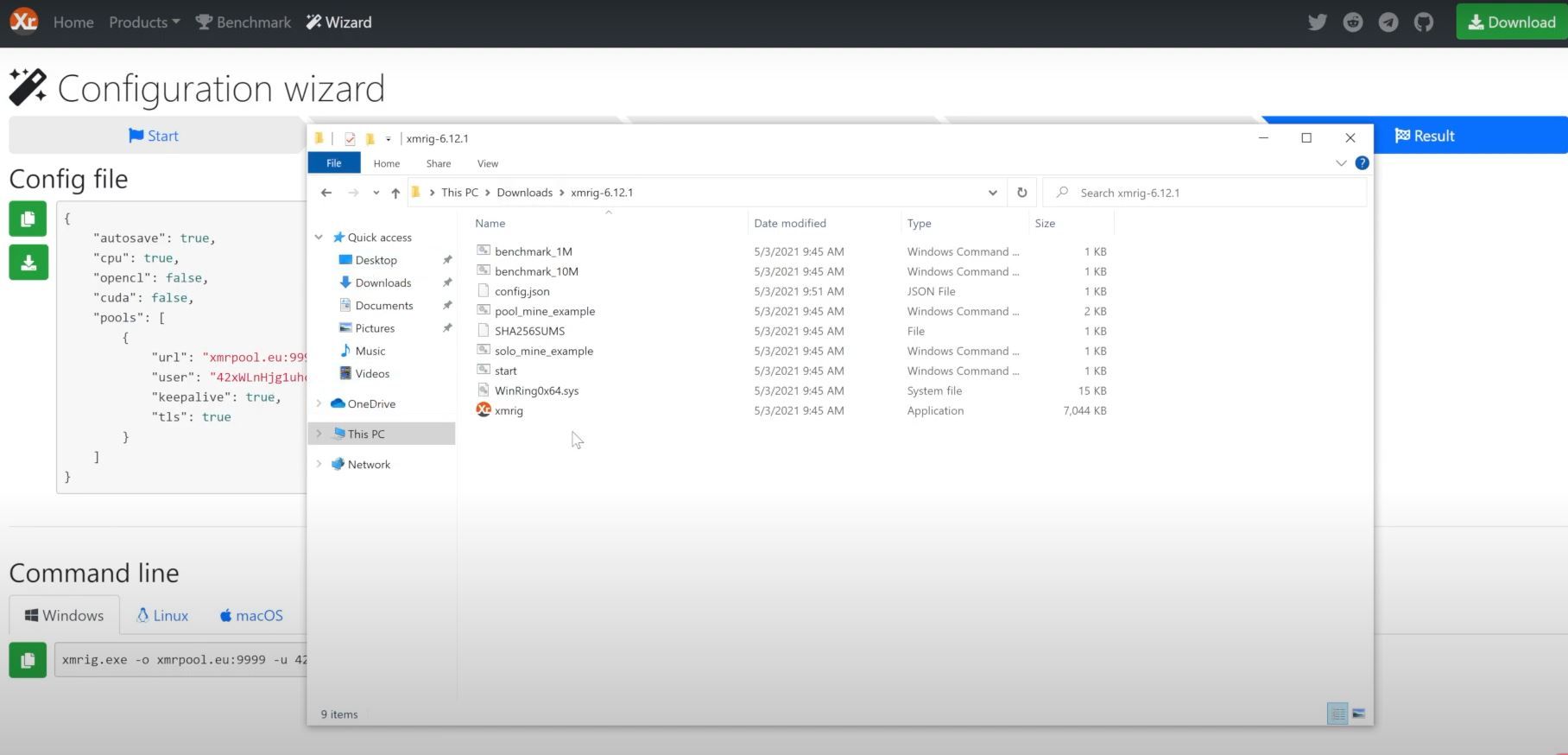
Now, you have the configuration file, the wallet, the mining pool, and are ready to run the monero mining software.
Run the software as administrator. It might take a second to connect to the mining pool. It should look like this:
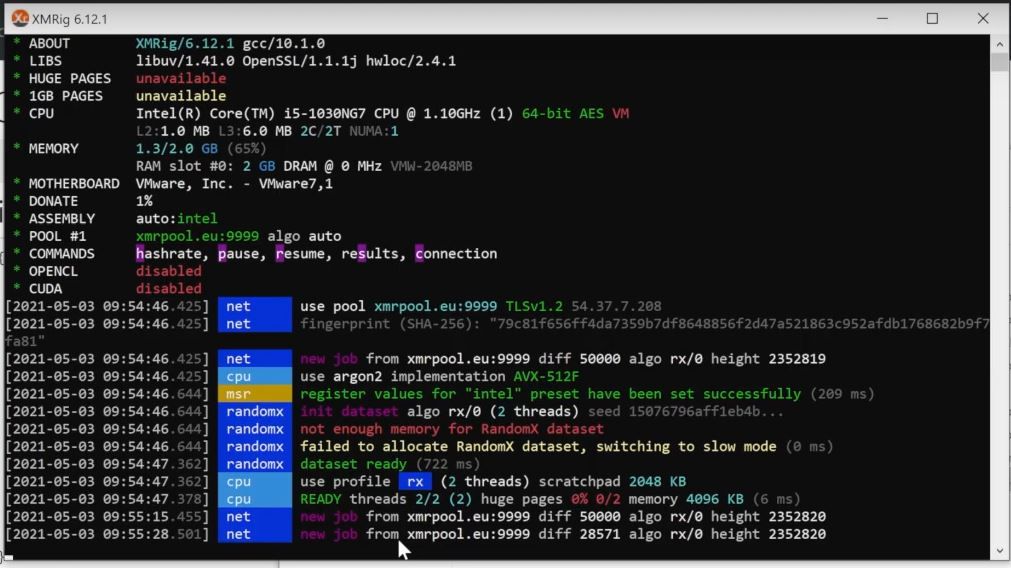
After you are connected to the mining pool, press “H” on the keyboard to see your current hash rate. Now, let’s check that you’re actually communicating with the chosen mining pool.
Go to the website of the chosen pool and paste your Monero wallet address to see your payment history.
As long as you see something there, it is a sign that your device is communicating with that monero mining pool. It should look something like this, depending on the chosen pool:
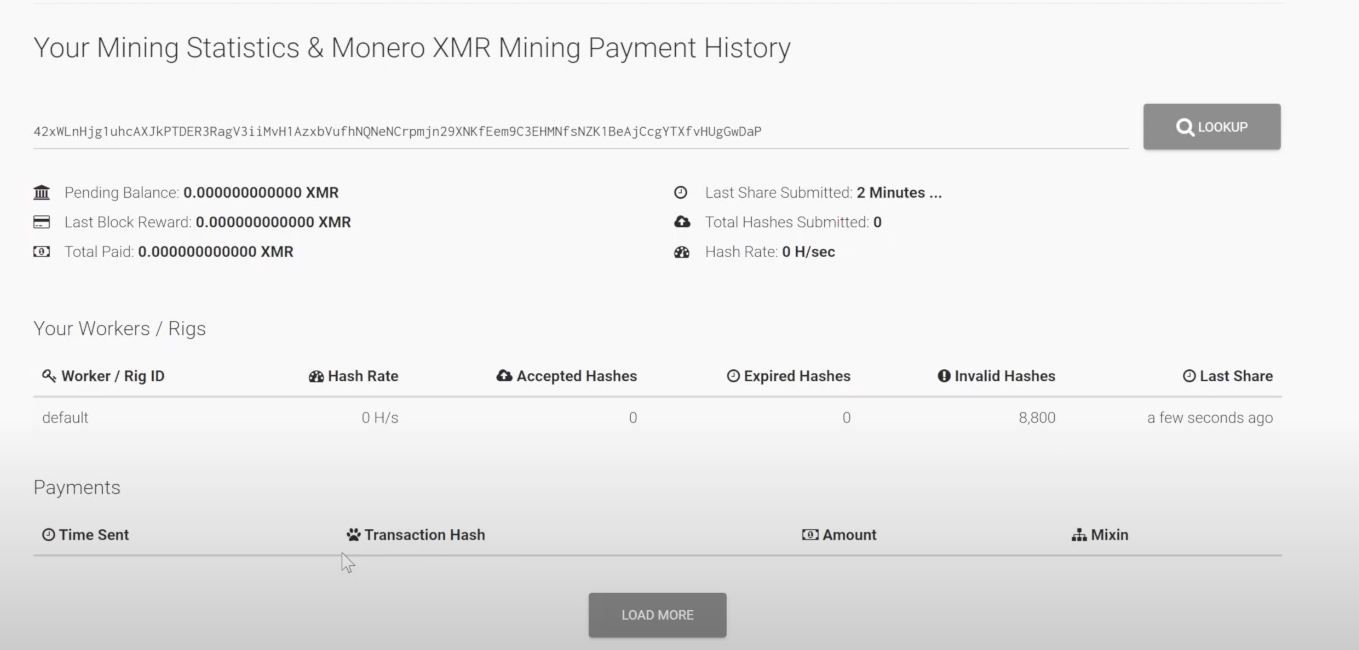
Remember that pools have minimum balances for payouts. Now, let your device do the work for you and wait for the XMR rewards. You will see your rewards directly in your wallet once the pool sends the first payout.
GPU mining
You can use your computer’s GPU to mine monero. The reason some miners prefer GPU to CPU mining is that a computer may only support two CPUs, but the number of GPUs can go up to 19. GPUs offer significantly higher hash rates when working together.
Gamers might be more inclined to use GPU mining as they already own a powerful GPU.
It’s worth checking out monerobenchmarks.info to see which GPU provides more hashing power. When comparing the prices of CPUs and GPUs, it is clearly more advantageous to have an inexpensive motherboard with multiple GPUs.
We will detail the steps for GPU mining for Nvidia GPU (CUDA) or AMD GPU (OpenCL).
The first four steps for GPU mining are the same as the ones listed under CPU mining. Please complete the steps and then follow the steps below.
Step 5: Generating the config.json file for XMRig
Just as in the case of CPU mining, you will need to follow the same steps for GPU mining.
You can generate the file needed for the monero mining software on the XMRig website. Go to “Wizard” > “+New Configuration” > “+Add Pool” (add the chosen mining pool) > “Add a Monero wallet address.”

Here you will need to enter the wallet address. Go to your wallet, copy the public address, and paste it here. Click “+Add pool.” You will see your pool added.
Go to the next step of the wizard, which is “Backends.” Select the corresponding GPU option for your GPU (AMD or NVIDIA).
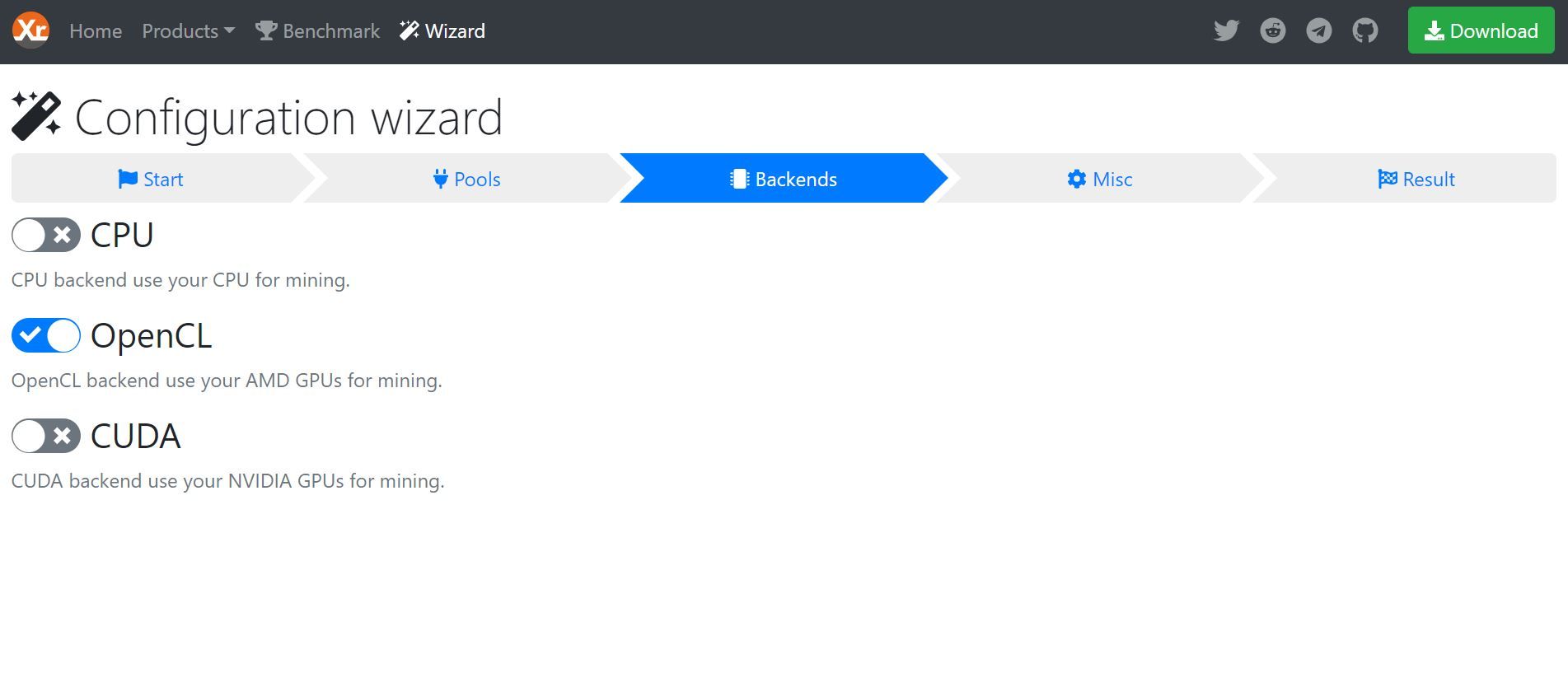
The next step is “Misc,” in which you can choose the percentage you want to donate to XMRig for writing the software.
Next, click on the “Result” tab to see and download the config file.

Download this config file and use it to replace the default file that came with the software in the folder you unzipped earlier.

Now, you have the configuration file, the wallet, and the mining pool, and you are ready to run the monero mining software.
Run the software as administrator. It might take a second to connect to the mining pool.

After you are connected to the mining pool, press “H” on the keyboard to see your current hash rate. Now, let’s check that you are actually communicating with the chosen mining pool.
Go to the website of the chosen pool and paste your monero wallet address to see payment history.
From device to digital gold: Mine XMR effortlessly
Mining Monero is now simpler and more accessible than ever, thanks to the blockchain’s commitment to privacy and equal opportunity. This setup allows anyone with a computer and a keen interest in cryptocurrencies to participate and earn passive income. By meticulously following the steps in our guide on how to mine XMR, you’re well on your way to successfully mining one of the most user-friendly cryptocurrencies available. Remember, as the value of XMR rises, so do your potential earnings. However, it’s wise to stay informed about the coin’s market value, your electricity expenses, and any pertinent local regulations.
< Previous In Series | Mining | Next In Series >
Frequently asked questions
Is monero mining profitable?
Is XMR easy to mine?
What is the most efficient way to mine monero?
How many monero are left?
Why is monero so hard to mine?
Is monero still mineable?
Is monero worth mining?
Is monero easy to mine?
What is the best hardware to mine monero?
How do I start monero mining?
How long does it take to mine 1 block of Monero?
Which is the best software to mine Monero?
How do I speed up Monero mining?
Does RAM affect monero mining?
Disclaimer
In line with the Trust Project guidelines, the educational content on this website is offered in good faith and for general information purposes only. BeInCrypto prioritizes providing high-quality information, taking the time to research and create informative content for readers. While partners may reward the company with commissions for placements in articles, these commissions do not influence the unbiased, honest, and helpful content creation process. Any action taken by the reader based on this information is strictly at their own risk. Please note that our Terms and Conditions, Privacy Policy, and Disclaimers have been updated.


